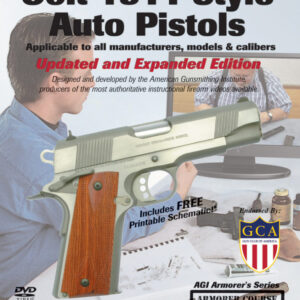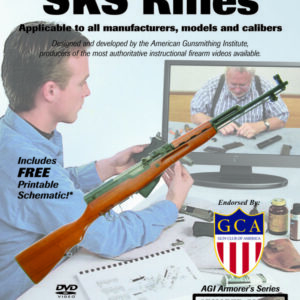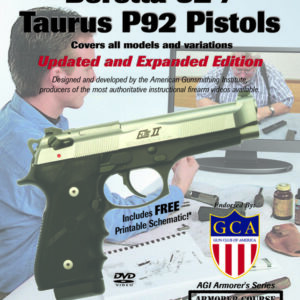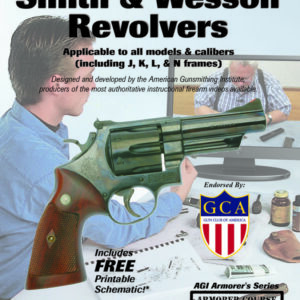Description
An excellent value for the money, the Mossberg 500 series has seen massive acceptance with sportsmen all over the world. However, these shotguns do have a few problems that this course will help you to solve inexpensively. In addition, numerous tricks and techniques are provided to insure reliable operation. Just the assembly and cleaning portion of this video course will save you $30-40. A rare factory cutaway is used to clearly demonstrate the inner workings.
If you want the quick course on how to get the Mossberg 500 Shotgun apart, back together, and operating as intended, then this course is for you (if you want the long course, look into our basic 108 hour Professional Gunsmith Course.)
Among the items covered are:
History
- Bob shares his knowledge of the history of Mossberg firearms and its founder, Oscar Mossberg
- While working for Iver Johnson, Oscar Mossberg invented the transfer bar, which is still used in many firearms today
- Oscar worked for different firearms manufacturers in America, until he and his partner made a four-barreled .22-caliber firearm. This was the gun that was first manufactured by him and his sons under the name O.F. Mossberg & Sons
- After manufacturing several models of firearms, they produced the first model of the Mossberg 500 in the early 1960s. Unlike many other firearms manufacturers, they continued to make the Mossberg 500 better and better through incremental design improvements, a process culminating with the excellent shotgun that they manufacture today
Design & Function
- Through the use of different cutaway firearms, we are shown the function and interaction of parts up close that we would not normally be able to see in their working environment
- The primary and secondary cartridge stops and their function are clearly shown and demonstrated
- With views both inside and outside of the gun, you are shown how the bolt functions against the bolt slide.
- Extreme close ups are shown of the bolt lock (locking block), and its function is explained
- The two extractors are shown and their differing functions are explained
- The sequence of cartridge feeding is demonstrated and explained in depth
- The ejector is shown and its function is explained
- The safety system is shown and explained
- Action bars are shown and their functions are explained
- Spare parts information is discussed
- Fire control system is shown and explained in depth
- Views of individual parts help us to understand their functions
Disassembly
- As the firearm is disassembled, Bob continues his explanation of how the various parts function
- Barrel removal is shown and explained
- Trigger guard removal is shown, along with the cartridge stops
- The bolt slide, elevator and bolt are removed from the receiver
- Magazine tube removal is shown and explained. Cautions are given
- Magazine spring is removed from the magazine tube and the follower is removed from the receiver
- Forearm and action bar assembly are shown being taken out of the receiver
- Buttstock removal is shown
- Safety disassembly is shown and explained
- Ejector removal from inside the receiver is demonstrated
- Bolt disassembly is shown and explained (bolt lock, firing pin and extractors)
- Trigger guard disassembly is shown and explained in depth (drawing a picture of the springs positions inside the trigger guard is suggested)
- Forearm disassembly is shown and explained (special tool is used)
Cleaning & Lubrication
- AGI cleaning & lubrication methods shown, along with the reasons for their use
- After cleaning, dry with air gun, or in the oven on Warm ~185-200 degrees (metal parts ONLY)
- Lubing the Bob way, and what kind he likes
Reassembly & Troubleshooting
- Safety reassembly is shown and explained
- Action bar assembly is installed into the forearm
- Magazine tube is reassembled, placed inside of the forearm and is shown being screwed into the receiver (tips are given for using a vise)
- Ejector reassembly is shown and explained
- Bolt is reassembled and explained (tips are given for extractor fit and function)
- Troubleshooting tips firing pin protrusion is shown and explained (positive protrusion is defined and specs are given)
- Troubleshooting tips new style bolt is shown and its variations are explained
- Trigger guard (housing) is reassembled. The specific order of parts being installed is shown and explained (special tools are shown, as well as how to make and use them)
- Function of various parts in the trigger housing is shown and described in depth
- Buttstock being reassembled onto the receiver is shown and tips are given for stock longevity
- The function of the elevator is shown and explained (tips for tuning and troubleshooting are given)
- The bolt, elevator and bolt slide are shown being installed into the receiver
- Cartridge stops are shown being installed into the receiver. Their functions are further explained
- Barrel being installed into receiver is shown
- Function and safety checks are explained and shown being performed
Accessories
- Various buttstocks are shown
- Various pistol grips are shown
- Various forearms are shown
- Shell holders are discussed and shown
- Front handguards (heat shields) are shown
If you noticed how often the terms explanation and demonstration are used, you may be getting some idea of why this course is necessary for any Mossberg 500 Shotgun owner, or someone who intends to be.




